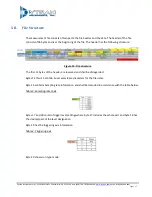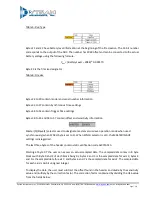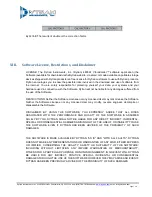
Dytran Instruments, Inc. 21592 Marilla St. Chatsworth, CA 91311 Phone: (818) 700-7818 Website:
email: [email protected]
Page | 14
X.
Time and Date Setup, MicroSD card method
As it was mentioned in 3.4 above, there is a second method of setting up time and date on the
device. Using the config.txt file, the user can record the desired time and date setting on the
MicroSD card (usually one would record current date and time which is in near future – couple of
minutes ahead), and by following these steps transfer those settings into the device RTC:
1)
Record time and date in the “Synchronous time” field of the SD card
2)
Create config.txt file
3)
Insert the card into the device while it’s powered off
4)
Press and hold “Record” button
5)
Press the “Power” button
6)
Release the “Record” button. The “Recording” indicator should light solid blue
7)
Press “Record” button again
As the user performs step 7 from above, the “Synchronous” time from the card is recorded to the
RTC.
Using this method, it is possible to synchronize two or more units. In order to do that, the same time
must be recorded into “Synchronous time” on two or more MicroSD card, the cards must be inserted
into the devices intended to be synchronized and the steps outlined above must be performed on
each device up until step 7. When all the devices intended for synchronization have the solid blue
light on (after step 6), the user must connect all the devices intended for synchronization with
synchronization cable and press the “Record” button on one of the devices. The synchronization
cable shall reproduce the button push on all the devices daisy chained together and the RTC timing
shall be synchronized.
XI.
Recording Synchronization Start versus Recording Synchronization
Clock
The synchronization connector described above can also be used to synchronously start the
recording on multiple units or to synchronize its sampling clocks. When the recordings are started
synonymously on two or more units, each of them still uses its own internal clock to sample. This
mode is referred to as “synchronous acquisition start”. When the “synch” option is selected during
the config file creation and units are designated as master and slaves, the slave units use the clock
input via synchronization cable or the optical input to obtain the sampling clock. This mode is
referred to as “synchronous sampling”.



















